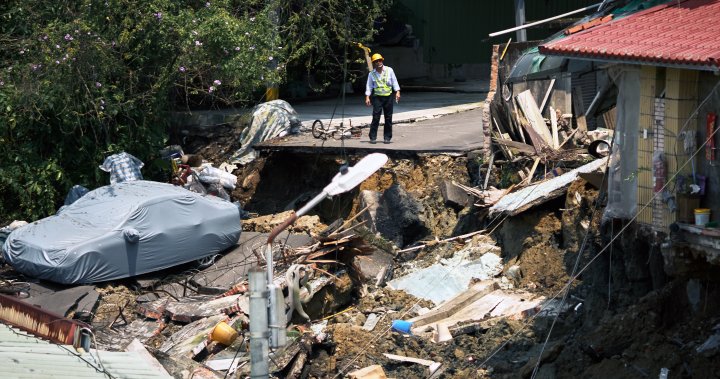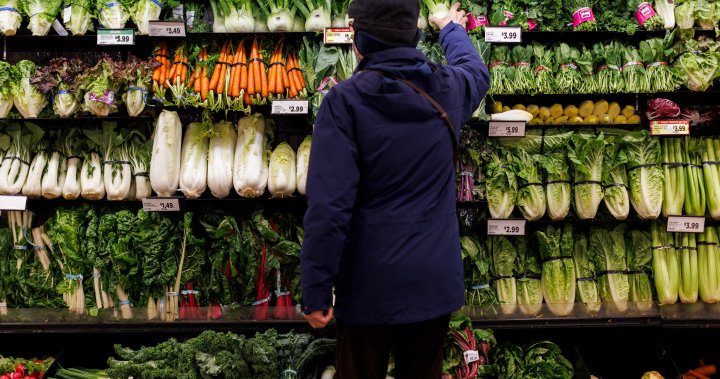Prime Minister Justin Trudeau says Canada “stands ready” to help Taiwan as it recovers from a 7.2 magnitude earthquake that has shaken the Asian island nation.
The earthquake, which was the biggest in Taiwan in at least 25 years, killed at least nine people and injured more than 900 on Wednesday; 50 hotel workers were missing en route to a national park, authorities said, as rescuers used ladders to bring others to safety.
“Canada stands ready to provide support and have reached out to Taiwanese officials,” Trudeau told reporters in Toronto on Wednesday.
“We’re also engaging to make sure affected Canadians have the support they need.”
A red building is partially collapsed after a powerful earthquake rocked the entire island on April 3, 2024 in Hualien County, Taiwan.
VCG via Getty Images
Two Canadians were among 12 individuals trapped the Sandimen Trail along the Central Cross-Island Highway, a spokesperson for Taipei Economic and Cultural Office in Canada told Global News.
The Canadians – a man and a woman – were rescued, they said. The woman was injured by falling rocks and received medical treatment at the scene before being transported to a hospital.
Global Affairs Canada updated its travel advisory for Taiwan on Wednesday warning of aftershocks and urging Canadians in the country to exercise caution.

Images taken by news photographers and TV cameras showed buildings tilted at precarious angles, rubble clogging mountainous roads and neighbourhood infrastructure completely ruined.
The email you need for the day’s
top news stories from Canada and around the world.
The quake hit at a depth of 15.5 kilometres Wednesday morning, just as people were headed for work and school, setting off a tsunami warning for southern Japan and the Philippines that was later lifted.
Video showed rescuers using ladders to help trapped people out of windows, while elsewhere there were massive landslides. Strong tremors in Taipei forced the subway system to close briefly, although most lines resumed service.
A view of rocks that fell and blocked the road after an earthquake struck off Taiwan’s eastern coast on the Richter scale, in Hualien, Taiwan on April 3, 2024. The Guguan Works Section sent out machines and tools to open the area, and called on people who wanted to enter the mountainous area to pay attention to the road conditions.
Taichung City Fire Department/Anadolu via Getty Images
Fire authorities said Wednesday they evacuated some 70 people trapped in tunnels near Hualien city, including two Germans.
But they had lost contact with 50 workers aboard four minibuses heading to a hotel in a national park, and rescuers were looking for them. Another 80 people are trapped in a mining area, though it was not immediately clear if they were inside a mine, Reuters reported.
The government put the number of injured at 946 as of Wednesday.
A vehicle in a collapsed road following an earthquake in New Taipei City, Taiwan, on Wednesday, April 3, 2024. Taiwan has been hit by the strongest earthquake in a quarter of a century, with shocks from the temblor levelling dozens of buildings on the eastern side of the island, injuring more than 50 people and disrupting some chip production lines.
An Rong Xu/Bloomberg via Getty Images
Japan’s weather agency put the quake’s magnitude at 7.7, saying several small tsunami waves reached parts of the southern prefecture of Okinawa, while downgrading its tsunami warning to an advisory.
In the Philippines, seismology officials warned coastal residents in several provinces to move to higher ground.
Chinese state media said the quake was felt in the southeastern province of Fujian, while a Reuters witness said it was also felt in the commercial hub of Shanghai.
Aftershocks could still be felt in Taipei, with more than 50 recorded as of Wednesday, weather officials said.
In this image taken from video footage run by TVBS, residents rescue a child from a partially collapsed building in Hualien, eastern Taiwan on Wednesday, April 3, 2024. A powerful earthquake rocked the entire island of Taiwan early Wednesday, collapsing buildings in a southern city and creating a tsunami that washed ashore on southern Japanese islands.
TVBS via AP
Most power has been restored and Taiwan’s two nuclear power stations were unaffected, electricity utility Taipower said.
The official central news agency said the quake was the biggest since one of magnitude 7.6 in 1999 that killed about 2,400 people and damaged or destroyed 50,000 buildings.
Taiwan weather officials ranked Wednesday’s quake in Hualien as “Upper 6,” or the second-highest level of intensity on a scale ranging from one to seven.
Firefighters carry out search and rescue operations among the rubble as at least nine people were killed and hundreds of others injured after an earthquake struck off Taiwan’s eastern coast in Hualien, Taiwan on April 3, 2024. Taiwan’s strongest earthquake in a quarter century rocked the island during the morning rush Wednesday, damaging buildings and creating a tsunami that washed ashore on southern Japanese islands.
Ministry of Interior / Handout /Anadolu via Getty Images
Such quakes collapse walls unless they are made of reinforced concrete blocks, while people cannot stand upright and must crawl in order to move, experts say.
— with files from Reuters
© 2024 Global News, a division of Corus Entertainment Inc.





